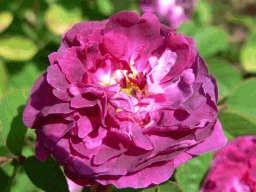Etymologie, Etimología, Étymologie, Etimologia, Etymology, (griech.) etymología, (lat.) etymologia, (esper.) etimologio
@_ Welt, Mundo, Monde, Mondo, World, (lat.) orbis (terrae), (esper.) mondo
Farbe, color, Couleur, Colore, Color, (esper.) farboj
A
B
C
Crimson Globe - Rose
Crimson Globe dr Dark Red, Moss (OGR) 1890
Diese Rose wurde ihrer Farbe entsprechend "Karmesinroter Globus" genannt. Unter "Globus" stellt man sich allerdings eine rundere Form vor.





Dieser "karmesinrote Globus" steht ebenfalls im Rosengarten Zweibrücken.
(E6)(L?) http://www.classicroses.co.uk/
(E?)(L?) http://www.helpmefind.com/rose/roses.php?tab=2&grp=C
Crimson Globe (Moss, Paul, 1890)
D
E
earthweb - CCB
CCB - Color Change Background
Farbwahl für Hintergrund
(E6)(L?) http://webdeveloper.earthweb.com/webjs/jsimage/item.php/666851_viewit
earthweb - Web Colors
Web Colors
Farben für das Web
(E6)(L?) http://webdeveloper.earthweb.com/webjs/jsutility/item.php/618571_viewit
Click on any block to get code
F
G
H
I
J
K
L
M
N
O
P
Q
R
S
T
U
V
vox.com - CN
The surprising pattern behind color names around the world
(E?)(L?) https://www.vox.com/
(E?)(L?) https://www.youtube.com/user/voxdotcom/videos
Vox Videos
(E?)(L?) https://www.youtube.com/watch?v=gMqZR3pqMjg
The surprising pattern behind color names around the world
(E?)(L?) http://wals.info/chapter/133
Chapter Number of Basic Colour Categories
by Paul Kay and Luisa Maffi cite
1. The World Color Survey
The following four maps (132A, 133A, 134A, 135A) show the distribution of colour terms in some of the world's languages, based on the World Color Survey. This project, a collaboration of researchers at the University of California, Berkeley, and the Summer Institute of Linguistics (SIL), collected colour-naming data from 110 languages being studied by SIL linguist-translators in the late 1970s. For further details on methods and results of the World Color Survey see Kay et al. (1991), Kay and Berlin (1997), Kay et al. (1997), Hardin and Maffi (1997), Kay and Maffi (1999).
...
(E?)(L?) https://en.wikipedia.org/wiki/Linguistic_relativity_and_the_color_naming_debate
Linguistic relativity and the color naming debate
The concept of linguistic relativity concerns the relationship between language and thought, specifically whether language influences thought, and, if so, how. This question has led to research in multiple disciplines—especially anthropology, cognitive science, linguistics, and philosophy. Among the most popular and controversial theories in this area of scholarly work is the theory of linguistic relativity (also known as the Sapir-Whorf hypothesis). An often-cited "strong version" of the claim, first given by Lenneberg in 1953, proposes that language structure determines how we perceive the world. A "weaker version" of this claim posits that language structure influences the world view of speakers of a given language but does not determine it.
...
(E?)(L?) https://stancarey.wordpress.com/2017/05/16/the-linguistics-of-colour-names/
The linguistics of colour names
The news website Vox has produced some good videos on linguistic topics, which can be found amidst their many other clips. Its latest one looks at the vexed question of colour names and categories in different languages, and in 6˝ minutes it offers a decent summary:
...
Erstellt: 2017-05
W
X
Y
Z




